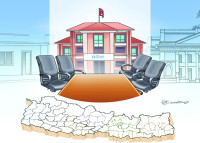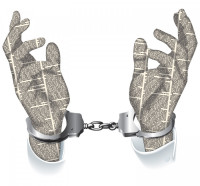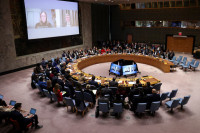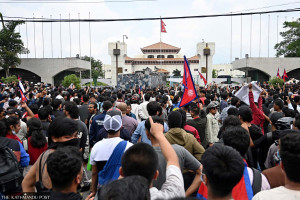Opinion
Archiving music
Bulu Mukarung, in a new volume, illustrates the spectrum of Nepali music’s history, styles, lyrics, and performativity.
A shared musical culture
In a unique way, this volume is a strong reminder of the fact that the political parties, especially those in government, do not appear to appreciate the nature of a shared culture in this country. The opposition’s hubris is that they did not meticulously use this power of shared culture of the peoples of diverse origins, groups, and practices right from the beginning, to promote a force that is invincible, because that expresses the people’s creative and cumulative power. But too much push and pull and a lack of tolerance for others’ cultures tends to ignore that energy in the political sphere.
This huge collection, created by the famous musician, scholar, and singer Bulu Mukarung, is one such important volume of records that brings the spectrum of history, music, lyrics, and performativity before us. I would like to say a few things regarding the pervasiveness and power of music, songs, and performance in this country.
We do not have a recorded history of music, either in the form of documents or in records to such a degree that they could be utilised to make academic studies at any time. Nobody has bothered to do so in a comprehensive manner. Neither has anybody or concerned organisations bothered to salvage the tremendously beautiful songs of yesteryear. Some people with good sense have somehow continued to sing these songs, and musical groups, mostly dubbed as Dalits, have carried these traditions alive to these days. Ambivalence and hypocrisy in their approach to music by the elites of this land can be seen in the use of musical traditions in this country. The feudal social system used music produced by traditional performers as recreational culture produced by the artists, who were put on the lower rungs of the social hierarchy. The other aspect of music was that it was patronised by the rulers, who in their palaces trained singers like Melwa Devi and Master Mitra Sen and scores of other known and unknown artists, several of whom this book puts in its records. Navaraj Lamsal, whose long introduction to this volume, puts this history eloquently.
Musical contradictions
The contradiction between entertainment and social segregation of musicians is at the core of Nepal’s musical culture. But some artists, poets, and singers have broken the silence and illuminated the interstices by singing out this contradiction. The late Jhalakman Gandharva and poet-singer Dharmaraj Thapa are two powerful examples. Thapa’s songs, which were once played on Radio Nepal and sung by many, have disappeared. But now, some music lovers have put them on Youtube. One such song is about the Buddha ‘who was born in Nepal’. This song is a powerful fusion of visuality, spatiality, commonness, love, and bonding. The song progresses in the subtle and melodious voice of a singer from Lumbini singing to the architectural sites, chaityas of Kathmandu, and monasteries in the Himalayas and Bhot. We have many examples of this nature.
Bulu Mukarung has put all these names, their biographical introductions, and the styles they used for their music. He is one such music researcher who has found records of connectivity between the singers and musicians of Darjeeling, Sikkim, and Assam and those of Nepal. Personally, he told me about Nepali classical singers trained in Nepali courts, who in their turn trained people in classical music in those other areas. Several years back, Bulu brought me a request from the Sikkimese Chief Minister Pawan Chamling to write my impressions about his songs, which I did. That is printed in a brochure for the record. But Bulu Mukurung’s connections are wider. As far as I understand, Bulu bhai is probably one of the few musicians and scholars who understand the public sphere of Nepali music, and no study that does not take this into account can produce anything meaningful.
The public sphere of Nepali music, as displayed by the hundreds of names of artists, styles, and groups compiled and introduced in this tome, is that it is a widening sphere. In later times, young people in each generation took up music as their hobby and even profession. A public sphere of an art like music has to encounter problems
too. The solution is found in two ways—one, find your audience and produce for them, and two, work with the political system and political groups. Bulu Mukarung has recorded the names and styles of musicians of both types. Those who worked inside Rana palaces and sang for Radio Nepal under the Panchayat, and those who wrote mainly for leftist groups are all included in this volume.
An achievement
At Sarwanam Theatre, when Bulu first showed me an unfinished sprawl of papers that he was preparing for this volume, I asked him what he wanted to achieve by this jumble. What he said then struck me. He said, “I want to create a visible record of names, styles, and movements that will automatically show different shifts in Nepali Sangeet.”
Indeed, Bulu Mukarung is working to show evidence of the public sphere of Nepali music through this collection. As Pradeep Bhattarai puts it in his short preface, one problem with such collection is whether it passes the test of being a book or not. But Bhattarai shares hope that this volume has come as an achievement. I too feel that this volume is the result of Bulu Mukarung’s many years of work and musical avidity, for which reason alone, it is a very important achievement.




 9.12°C Kathmandu
9.12°C Kathmandu











